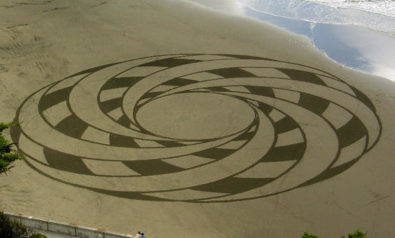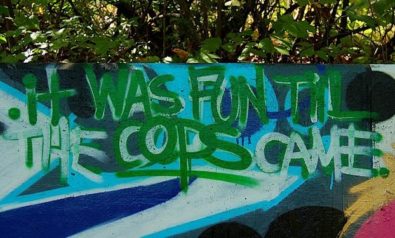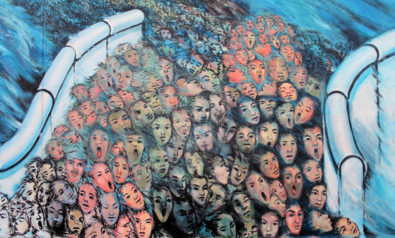Marie-Jeanne Berger looks at the (post)revolutionary art scene rising from the streets of downtown Cairo.
I’ll Die Anyways
“I feel lucky that I as an artist haven’t been persecuted during the time of Mubarak,” says Egyptian cartoonist Makhlouf. “Not like [assassinated Palestinian cartoonist] Naji al-Ali, or [imprisoned and released illustrator] Essam Hanafi. But I also think that if it happened, it means you are stronger than them. I’ll die anyways. If I die and am influential in society, that’s okay.”
Makhlouf, who uses only his first name, is the co-founder of Tok Tok, an illustrated magazine. The publication is one of many local initiatives now thriving in the euphoric energy that has settled in downtown Cairo since the revolution. It is named after the Indian-made three-wheeled vehicles commonly found in the narrow streets that make up the poorest areas of Cairo.
In addition to new publications, young Egyptians have started organisations to support their art and activism. There is a filmmaking cooperative called Mosireen (a play on the Arabic word for Egyptians and “determined”); an artist organisation, Mahatat (meaning “stations”); and the spontaneous and city-wide graffiti movement, which has seen public spaces covered with political art.
This youth-led art movement is a reflection of street culture, and the street also serves as a backdrop. Makhlouf, now 30, was among the thousands of youth who did battle in Tahrir Square during the year-long revolution. At one point, he was even reported as having been killed.
In December 201,1 there were fierce clashes between protesters and riot police at the Egyptian Cabinet Building in downtown Cairo. “One of my friends called to ask if I was alright,” says Makhlouf. The friend had heard that the illustrator was dead.
“I had been there that day in the morning. Then, at night, there was a story that another artist with my name had died. The news was published on the Internet. I discovered he was an illustrator like me, also a young man. We had the same exact name, and he even looked like me,” he recalled. “I felt at this time, it was very likely that he had died instead of me. For everyone who lives today, there is someone who died during the revolution.”
Tok Tok
Makhlouf started Tok Tok with fellow artists Shennawy, Andeel, Hisham Rahma and Tawfeeq. The first issue was published on the brink of the revolution, on January 1, 2011. “The magazine comes from the simple ideas of the people, what happens in the street, especially with youth,” says Makhlouf.
The humor is irreverent, even earthy. The first comic strip he drew for Tok Tok was more about daily life rather than revolutionary politics: “I made this male character called George Sabry. He’s an illustrator. His wife comes home with a breast enlargement. She wants to show him, but he’s angry because he’s working. They fight.”
While Tok Tok doesn’t espouse an explicitly activist agenda, the backdrop for the cartoons and comic strips – the street – makes it political. Makhlouf continues: “The second issue that we published was about the revolution. I decided to do a comic about what it would be like if I was president of the republic, what if?
“The Egyptian people imagined that when [President Hosni] Mubarak left, everything would change. The poor would eat, the sick would heal and workers would be treated better. Things would be solved and we would be better people. Then it appeared that after he left, there was no plan. Nobody knew anything about politics.”
After three decades of repression by the Mubarak regime, Egypt is ready for a change, says Makhlouf, and education must be a priority.
“In France, when the [French Revolution] happened, it started a new type of art and a new type of society,” he says. To this end, he and his colleagues are holding workshops for budding cartoonists and starting another publication aimed at promoting up and coming illustrators.
Mosireen Media Collective
The Mosireen Media Collective focuses on filmmaking. The collective became famous after it posted video footage of violent street battles onto online sites, effectively countering state media reports which downplayed the extent of the protests.
Khalid Abdalla is a co-founder of Mosireen, as well as Tahrir Cinema and Cimatheque. The Cambridge-educated Abdalla explained: “People were making videos either to try to get their friends out of prison, or to try and represent what was happening in the streets.” What was needed were editing skills, access to equipment and a safe place for people to work.
On October 9, 2012, hundreds of Egyptian Copts gathered for a peaceful protest to commemorate the deaths of at least 27 Christians one year earlier. They died when armoured personnel carriers mowed into the crowds, crushing people in their path. Mosireen went into action, uploading videos that challenged the state’s claims that its forces were not responsible for the deaths.
“Suddenly we had a large number of people working, filming, editing and uploading videos to YouTube channels,” Abdalla recalls.
During those months, Mosireen became the most-watched non-profit YouTube channel in Egypt. By January 2013, the collective was the most-watched non-profit channel in the world. But their main goal was to develop networks across Egypt, to film events happening in the street, and share them with citizens. Out of this came Tahrir Cinema, using large screens set up in cities throughout Egypt to show citizen-filmed footage from the streets.
Since the overthrow of Mubarak, Mosireen is looking ahead. Abdalla says: “Now is the period where consolidating what you built and widening your networks is essential. Bearing in mind that great periods of social unrest and social change come in waves, you learn very quickly that some waves you let pass, while you work on other things that are important to you. The presidential wave is a different process to the more street-oriented [one] that Mosireen is concentrating on. We’re trying to empower a street-level perspective helping to give voice to voices that are otherwise marginalized.”
Mahatat
Another Cairo-based group, Mahatat, has been focusing on just that — the street as audience. For this performance-based group, the street becomes a backdrop and an actor for the events that unfold. Where Mosireen is political, Mahatat is dealing with cultural politics, and the politics of art.
“We wanted to start something new,” says co-founder Astrid Thews. “The reason was [to criticise] a fairly closed, centralized and elitist art scene. We wanted to break out of this.” Thews narrowed the problem down to one thing: the homogeneity of the audience. “We debated whether to get a venue or not, and we decided against it because we thought it was very likely that it would just attract the usual subjects.”
Mahatat launched their first project, Shawara’ana (Our Streets), early last year. Dance, mime and “social clowning” took place in various locations around Cairo, including metro stations and public squares.
Thews says: “We felt that if we wanted accessible places where there [was] a diverse mix of people, that it would make more sense to do this in public spaces, whether for performances or installations. So our main goals in this sense are accessibility and decentralization.”
Like Abdalla, Thews emphasizes that they are working on projects across the country to develop local artistic communities. Their next project will take place in the Delta, north of Cairo, with a series of workshops that will culminate in a local public performance broadcast to Alexandria and Cairo.
“Although the prominent visible scenes are mainly in Cairo and partly in Alex, there are art initiatives happening all over the country that [are] lacking opportunities, training and financial resources, rehearsal venues: you name it,” says Thews. “So the idea is when we talk about initiatives, we don’t want to start with something completely new, but to engage in partnerships with local initiatives that already exist.”
Art as Metaphor?
Breaching the gap between the art establishment and local initiatives has been the biggest obstacle in aiding young artists, but since the February 2011, there has been an unprecedented level of collaboration. An example of this collaboration was on display last year at the Safar Khan gallery in Zamalek, the fashionable island neighbourhood of Cairo.
Police tape criss-crossed the windows of the gallery: “beware inside," reads the Arabic text. "Visual material may affect thought and mood.” While the police tape was a clever way to promote a new art exhibit, the warning was genuine. The exhibit was of graffiti art, the defining motif of Egypt's youth-led revolution. In the year of unrest that brought an end to President Hosni Mubarak's three decade-long rule, more than 1,000 protesters were killed, and as many as 80 lost eyes to police marksmen.
“Graffiti isn’t necessarily political,” said Mona Said, curator of the Safar Khan Gallery. “It is social, and sometimes territorial, and it has flourished the most [out] of the plastic arts since the revolution.” Spray paint is accessible and cheap, and tagging is a way of claiming ownership over the public space while conveying a message that will be seen by a broad swathe of society. An art form previously distinguished by its public, valueless nature, has, like everything else deemed cool, transitioned easily into the commodifiable.
Hosting an exhibition of the graffiti artists Ganzeer, Taneen, Shank, Okasha and Nadeem, Said says, was truly a risk. Among the graffiti drawings is an injured and bandaged street cat.
Arabic script running across the walls read: “The people have f***ed me. One day they kick me and the next day they make me into hawawshy (a cheap meat sandwich). It’s as if they’ve forgotten how important I am.”
Is the cat a metaphor for what awaits the youth who led this revolution? For initiatives like Mahatat, Mosireen, and Tok Tok, the aim is to make sure that the wider population remembers the role that young people played in bringing democratic elections to their country — a role that has been reprised since the anniversary of Mohammed Mahmoud on November 19. For now, these street-focused efforts are thriving, empowering youth and making sure that their voices are heard.
“This is our first revolution,” says the Cairo illustrator Makhlouf. “We made a lot of mistakes. But hopefully, our children, when they start a revolution after 30 years, they won’t make the same mistakes.”
*[This article was originally featured by the Arab Spring Collective.]
The views expressed in this article are the author's own and do not necessarily reflect Fair Observer’s editorial policy.
Image: Copyright © Shutterstock. All Rights Reserved.
Support Fair Observer
We rely on your support for our independence, diversity and quality.
For more than 10 years, Fair Observer has been free, fair and independent. No billionaire owns us, no advertisers control us. We are a reader-supported nonprofit. Unlike many other publications, we keep our content free for readers regardless of where they live or whether they can afford to pay. We have no paywalls and no ads.
In the post-truth era of fake news, echo chambers and filter bubbles, we publish a plurality of perspectives from around the world. Anyone can publish with us, but everyone goes through a rigorous editorial process. So, you get fact-checked, well-reasoned content instead of noise.
We publish 2,500+ voices from 90+ countries. We also conduct education and training programs
on subjects ranging from digital media and journalism to writing and critical thinking. This
doesn’t come cheap. Servers, editors, trainers and web developers cost
money.
Please consider supporting us on a regular basis as a recurring donor or a
sustaining member.
Will you support FO’s journalism?
We rely on your support for our independence, diversity and quality.









Comment